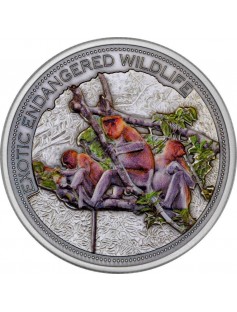- Mintage Limit - 500
- Coin with Colour Printed
- Each coin minted from 2Oz of pure silver
- Coin in capsule+with Certificate of Authenticity + Presentation Case
The Proboscis Monkey, also called “Nose-Monkey” with its huge snout that keeps growing throughout its life wins by a nose for having the biggest proboscis of any other primates on earth!
Humans might run for cover with this nose, but for the proboscis monkey, the bigger the nose the better! It turns out that nothing turns on a female proboscis monkey more than a big, bulbous nose.
Scientists think these outsize organs create an echo chamber that amplifies the monkey’s call, impressing females and intimidating rival males. Proboscis monkeys are endemic to the jungles of Borneo, never straying far from the island’s rivers, coastal mangroves, and swamps. They are a highly arboreal species and will venture onto land only occasionally to search for food. They live in organized harem groups consisting of a dominant male and two to seven females and their offspring. Proboscis monkeys are the primate world’s most prolific swimmers, frequently leaping from tree limbs and hitting the water with a comical belly flop. They’ve evolved webbed feet and hands to help them outpace the crocodiles that are some of their main predators.
Among the largest of Asia’s monkeys, male proboscis specimens can reach 23 kilograms, although females attain only about half that size. Adults wear a coat of light brown fur that turns red around the head and shoulders and gray at the arms, legs, and tail. Only males develop the namesake nose. The proboscis monkey is assessed as Endangered in the IUCN Red List of Threatened Species and listed in Appendix I of CITES. Its total population has decreased by more than 50% in the past 36–40 years due to ongoing habitat loss and hunting in some areas.
The population is fragmented: the largest remaining populations are found in Kalimantan, there are far fewer in Sarawak, Brunei and Sabah. The proboscis monkey is protected by law in Borneo and Malaysia.


